Impact Tendency Characteristics of Borehole Coal Samples under Real-Time and Uniaxial Loading Conditions: Insights from Physical Experiments
Abstract
1. Introduction
2. Experimental Scheme
2.1. Sample Preparation
2.2. Experimental Procedure
2.3. Calculation Method and Standard of Impact Tendency Index
3. Results and Analysis
3.1. Uniaxial Compressive Strength
3.2. Dynamic Failure Duration
3.3. Elastic Energy Index
3.4. Impact Energy Index
4. Conclusions
Author Contributions
Funding
Data Availability Statement
Conflicts of Interest
References
- Li, Q.; Li, Y.; Cheng, Y.; Li, Q.; Wang, F.; Wei, J.; Liu, Y.; Zhang, C.; Song, B.; Yan, C.; et al. Numerical simulation of fracture reorientation during hydraulic fracturing in perforated horizontal well in shale reservoirs. Energy Sources Part A 2018, 40, 1807–1813. [Google Scholar] [CrossRef]
- Li, Q.C.; Cheng, Y.F.; Li, Q.; Zhang, C.; Ansari, U.; Song, B.J. Establishment and evaluation of strength criterion for clayey silt hydrate-bearing sediments. Energy Sources Part A 2018, 40, 742–750. [Google Scholar] [CrossRef]
- Xie, H.P.; Ju, Y.; Gao, F.; Gao, M.Z.; Zhang, R. Groundbreaking Theoretical and Technical ConceptUalization of Fluidized Mining of Deep Underground Solid Mineral Resources. Tunn. Undergr. Space Technol. 2017, 67, 68–70. [Google Scholar] [CrossRef]
- Wen, J.L.; Li, H.S.; Jiang, F.X.; Yu, Z.X.; Ma, H.T.; Yang, X.L. Rock Burst Risk Evaluation Based on Equivalent Surrounding Rock Strength. Int. J. Min. Sci. Technol. 2019, 29, 571–576. [Google Scholar] [CrossRef]
- He, M.C.; Wang, Q. Rock Dynamics in Deep Mining. Int. J. Min. Sci. Technol. 2023, 23, 1065–1082. [Google Scholar] [CrossRef]
- Mahdi, A.; Ali, S.; Alain, R.; Patrick, M.L. Rockburst in Underground Excavations: A review of Mechanism, classification, and prediction methods. Undergr. Space 2022, 7, 577–607. [Google Scholar]
- Konicek, P.; Soucek, K.; Stas, L.; Singh, R. Long-hole Destress Blasting for Rockburst Control During Deep Underground Coal Mining. Int. J. Rock Mech. Min. Sci. 2013, 61, 141–153. [Google Scholar] [CrossRef]
- Li, C.C.; Zhao, T.B.; Zhang, Y.B.; Wan, W.K. A Study on The Energy Sources and The Role of The Surrounding Rock Mass in Strain Burst. Int. J. Rock Mech. Min. Sci. 2022, 154, 105114. [Google Scholar] [CrossRef]
- Wu, Y.Z.; Gao, F.Q.; Chen, J.Y.; He, J. Experimental Study on the Performance of Rock Bolts in Coal Burst-Prone Mines. Rock Mech. Rock Eng. 2019, 52, 3959–3970. [Google Scholar] [CrossRef]
- Kang, H.P.; Lv, H.W.; Zhang, X.; Gao, F.Q.; Tian, J.Z.; Yi, Z.Y. A New Ground Control Measure for Double-use Entries in Underground Coal Mines. Int. J. Rock Mech. Min. Sci. 2022, 160, 105266. [Google Scholar] [CrossRef]
- Fu, Y.K.; Wu, Y.Z.; Li, J.C.; Zhou, P.Z.; Sun, Z.Y.; He, J. Mechanical Properties and Energy Evolutions of Burst-prone Coal Samples with Holes and Fillings. Int. J. Coal Sci. Technol. 2024, 11, 40. [Google Scholar] [CrossRef]
- Song, D.; Wang, E.; Liu, Z.; Liu, X.; Shen, R. Numerical Simulation of Rock-burst Relief and Prevention by Water-jet cutting. Int. J. Rock Mech. Min. Sci. 2014, 70, 318–331. [Google Scholar] [CrossRef]
- Gu, X.B.; Gong, X.F.; Zhang, C.G.; Gu, Y.S.; Wang, C.; Wang, G.M.; Guo, W.Y. Drilled-hole Number Effects on Energy and Acoustic Emission Characteristics of Brittle Coal. J. Mater. Res. Technol. 2023, 23, 3892–3903. [Google Scholar] [CrossRef]
- Wang, K.; Zhang, X.; Du, F.; Li, K.; Sun, J.; Wang, Y. Numerical Study on Damage Response and Failure Mechanism of Gas-containing Coal-rock Combination under Confining Pressure Effect. Fuel 2023, 349, 128683. [Google Scholar] [CrossRef]
- Liu, X.R.; Yang, S.Q.; Huang, Y.H.; Cheng, J.L. Experimental Study on the Strength and Fracture Mechanism of Sandstone Containing Elliptical Holes and Fissures under Uniaxial Compression. Eng. Fract. Mech. 2019, 205, 205–217. [Google Scholar] [CrossRef]
- Wu, H.; Zhao, G.Y.; Liang, W.Z. Investigation of Cracking Behavior and Mechanism of Sandstone Specimens with a Hole under Compression. Int. J. Mech. Sci. 2019, 163, 105084. [Google Scholar] [CrossRef]
- Li, Y.C.; Qu, Y.D.; He, Q.Y.; Tang, C. Mesoscale Numerical Study on the Evolution of Borehole Breakout in Heterogeneous Rocks. Int. J. Numer. Anal. Methods Geomech. 2020, 44, 1219–1236. [Google Scholar] [CrossRef]
- Zhang, S.C.; Li, Y.Y.; Shen, B.T.; Sun, X.Z.; Gao, L.Q. Effective Evaluation of Pressure Relief Drilling for Reducing Rock Bursts and Its Application in Underground Coal Mines. Int. J. Rock Mech. Min. Sci. 2019, 114, 7–16. [Google Scholar] [CrossRef]
- Yin, Y.C.; Chen, B.; Zhang, Y.B.; He, S.D.; Yao, C.R.; Liu, C.C. Experimental Study and Evaluation on the Weakening of Bursting Liability of Coal with Boreholes. Eng. Fail. Anal. 2024, 155, 107754. [Google Scholar] [CrossRef]
- Chen, M.; Zhang, Y.L.; Zang, C.W.; Zhang, G.C.; Li, Q.; Jiang, B.Z. Experimental Investigation on Pressure Relief Mechanism of Specimens with Prefabricated Reaming Boreholes. Rock Mech. Rock Eng. 2023, 56, 2949–2966. [Google Scholar] [CrossRef]
- Lu, J.; Yin, G.Z.; Zhang, D.M.; Li, X.; Huang, G.; Gao, H. Mechanical Properties and Failure Mode of Sandstone Specimen With a Prefabricated Borehole under True Triaxial Stress Condition. Geomech. Energy Environ. 2021, 25, 100207. [Google Scholar] [CrossRef]
- Ren, F.Q.; Zhu, C.; Karakus, M.; He, M.C. Rockburst Mitigation Mechanisms of Pressure Relief Borehole and Rock Bolt Support: Insights from Granite True Triaxial Unloading Rockburst Tests. Eng. Geol. 2024, 336, 107571. [Google Scholar] [CrossRef]
- Zeng, W.; Yang, S.Q.; Tian, W.L. Experimental and Numerical Investigation of Brittle Sandstone Specimens Containing Different Shapes of Holes under Uniaxial Compression. Eng. Fract. Mech. 2018, 200, 430–450. [Google Scholar] [CrossRef]
- Chen, S.J.; Xia, Z.G.; Feng, F.; Yin, D.W. Numerical Study on Strength and Failure Characteristics of Rock Samples with Different Hole Defects. Bull. Eng. Geol. Environ. 2020, 80, 1523–1540. [Google Scholar] [CrossRef]
- Fan, X.; Li, K.H.; Lai, H.P.; Xie, Y.L.; Cao, R.H.; Zheng, J. Internal Stress Distribution and Cracking Around Flaws and Openings of Block Under Uniaxial Compression: A Particle Mechanics Approach. Comput. Geotech. 2018, 102, 28–38. [Google Scholar] [CrossRef]
- GB/T 25217.2–2010; Standardization Administration of China. Methods for Determination, Monitoring and Prevention of Rock Burst Part 2: Classification of Coal Burst Tendency and Determination of Index [S]. China Standard Press: Beijing, China, 2010.
- Ju, M.H.; Yao, B.S.; Kou, D.M.; Cai, W.; Cao, A.Y.; Kan, Z.H. Influence of Coal Bursting Liability on Physical Similarity Simulation of Coal/rock Burst. China J. Rock Mech. Eng. 2024, 43, 0441. [Google Scholar]
- Li, X.S.; Wang, Q.; Wu, K.B.; Wang, J.M.; Qi, Q.X. Microscopic fracture evolution and propagation mechanism of coal with high coal burst liability. Theor. Appl. Fract. Mech. 2024, 130, 104331. [Google Scholar] [CrossRef]
- Wang, A.W.; Gao, Q.S.; Pan, Y.S.; Song, Y.M.; Li, L. Bursting liability and energy dissipation laws of prefabricated borehole coal samples. J. China Coal Soc. 2021, 46, 959–972. [Google Scholar]
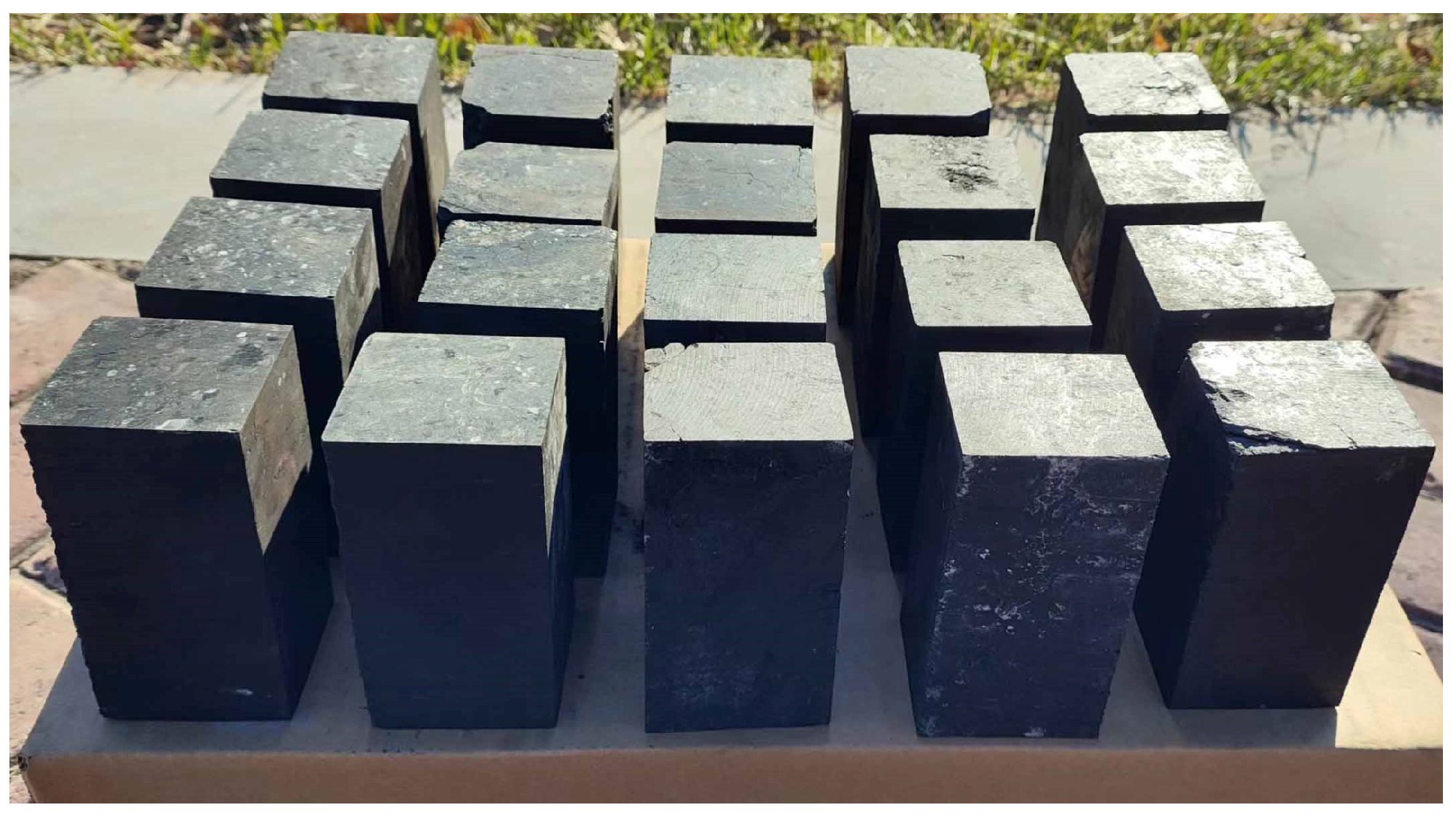
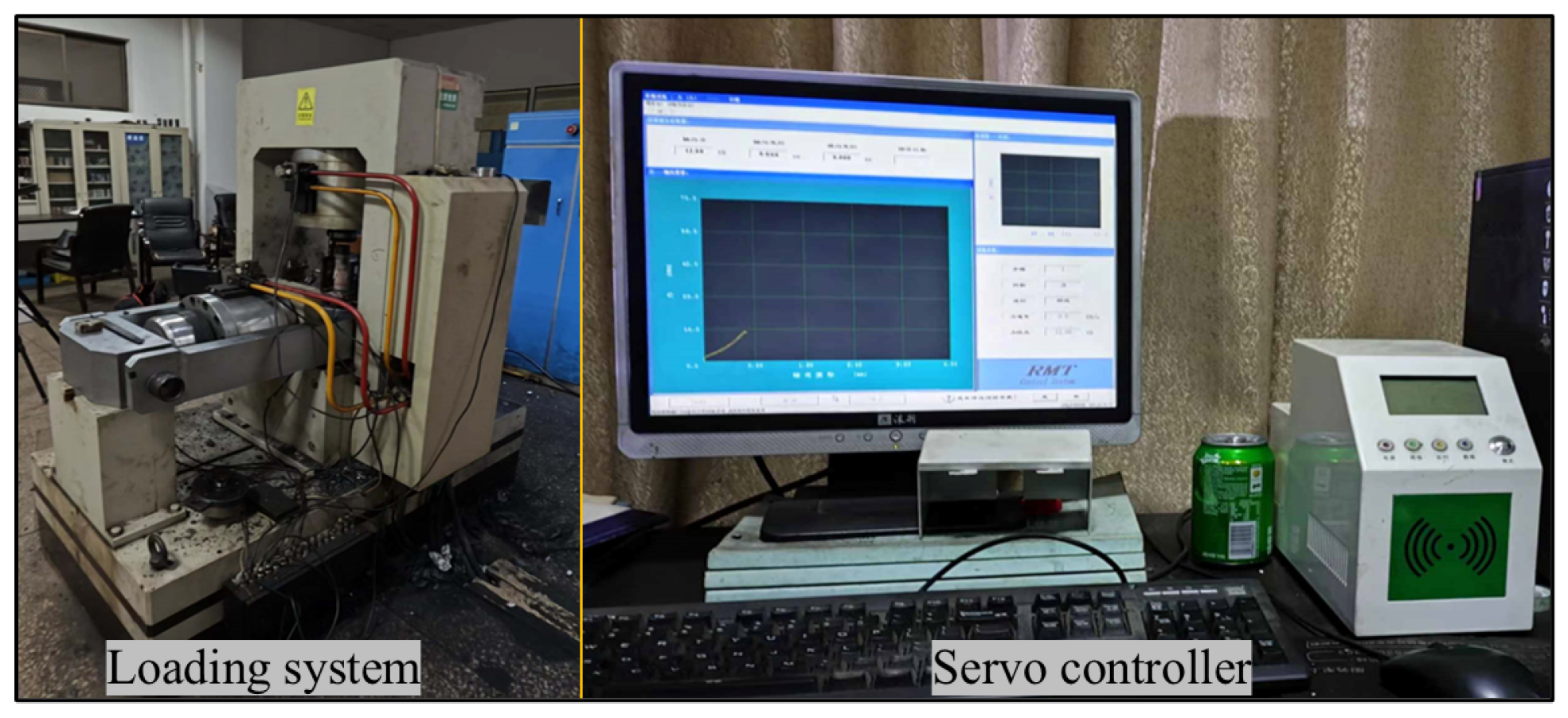

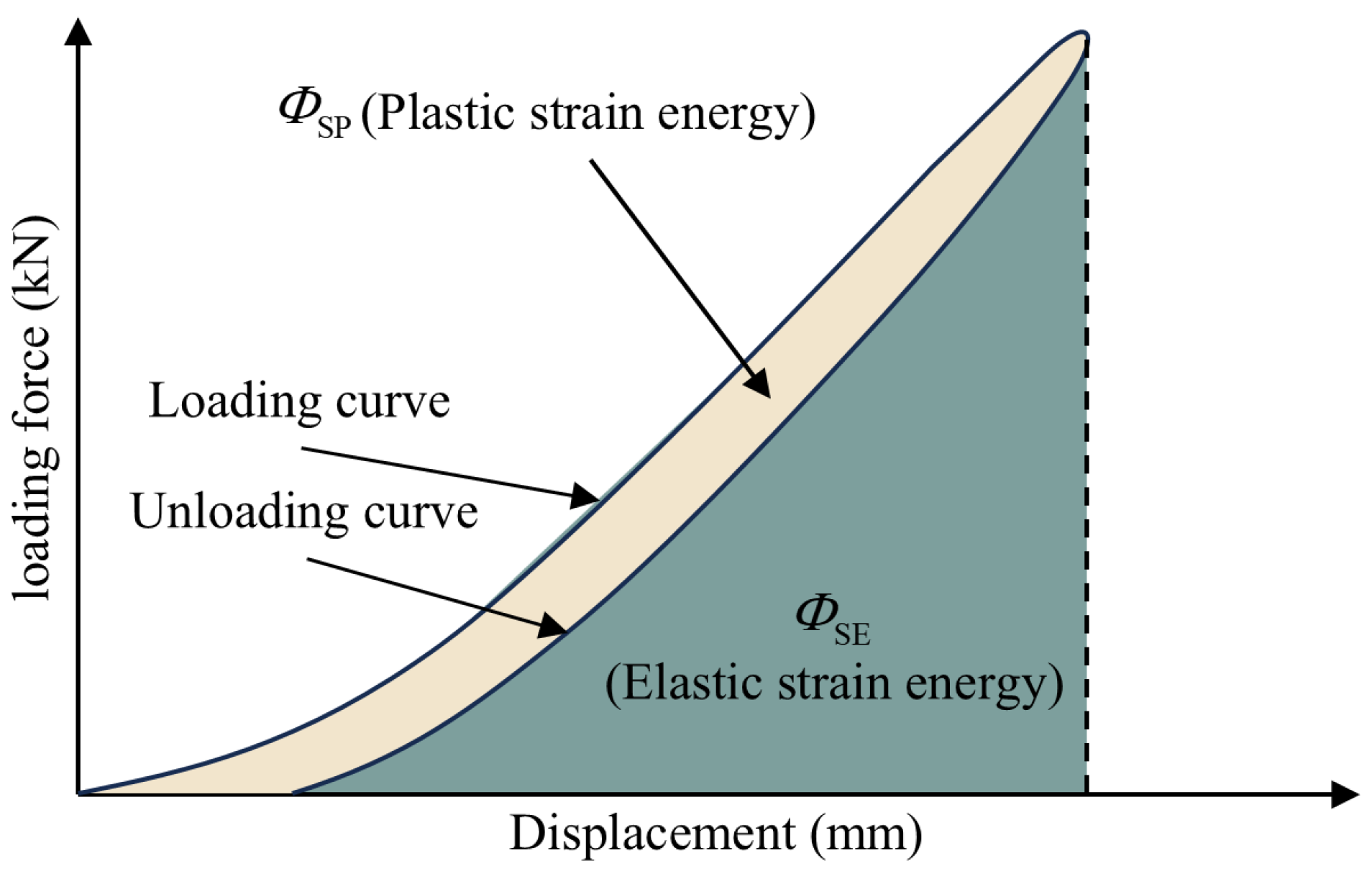
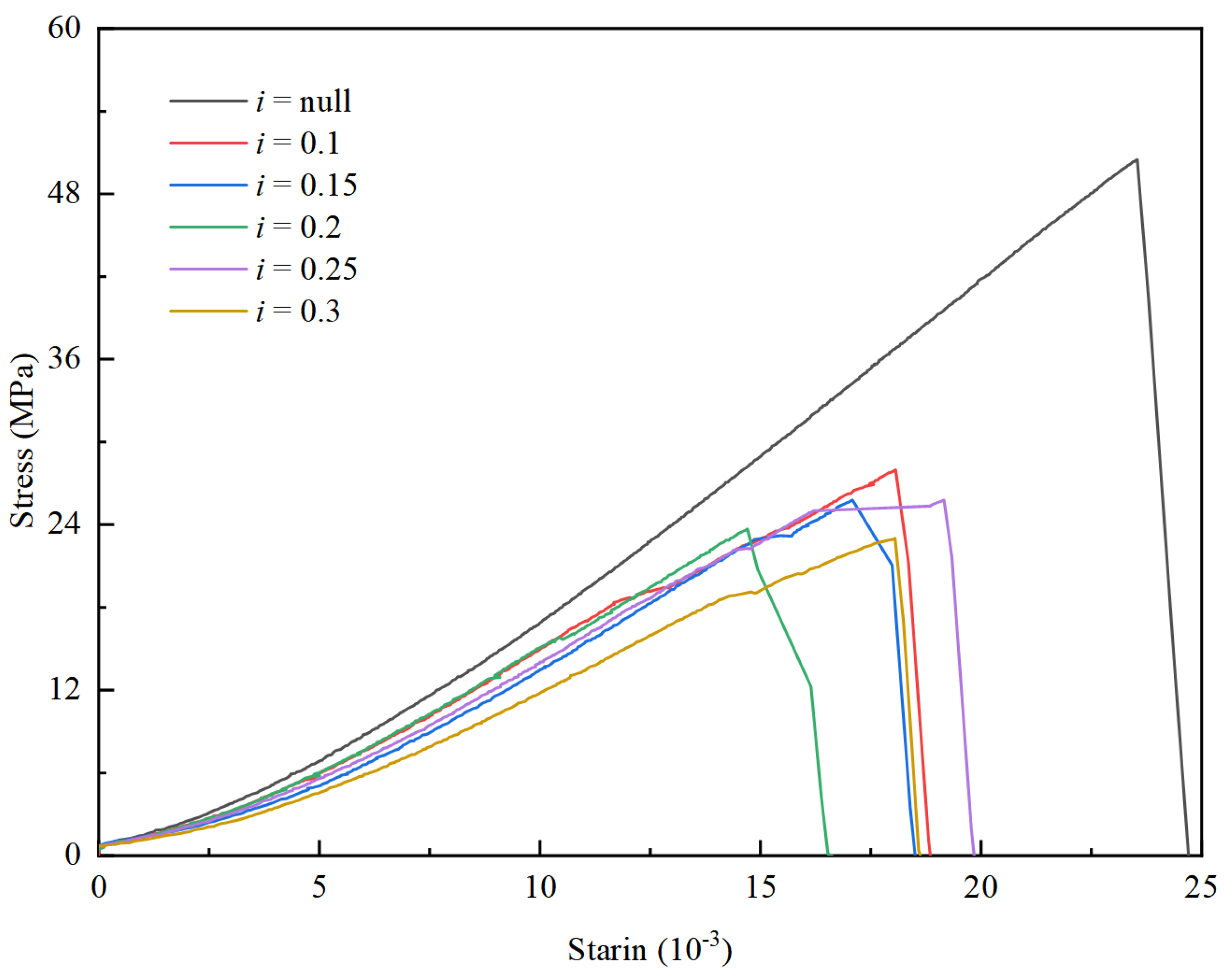
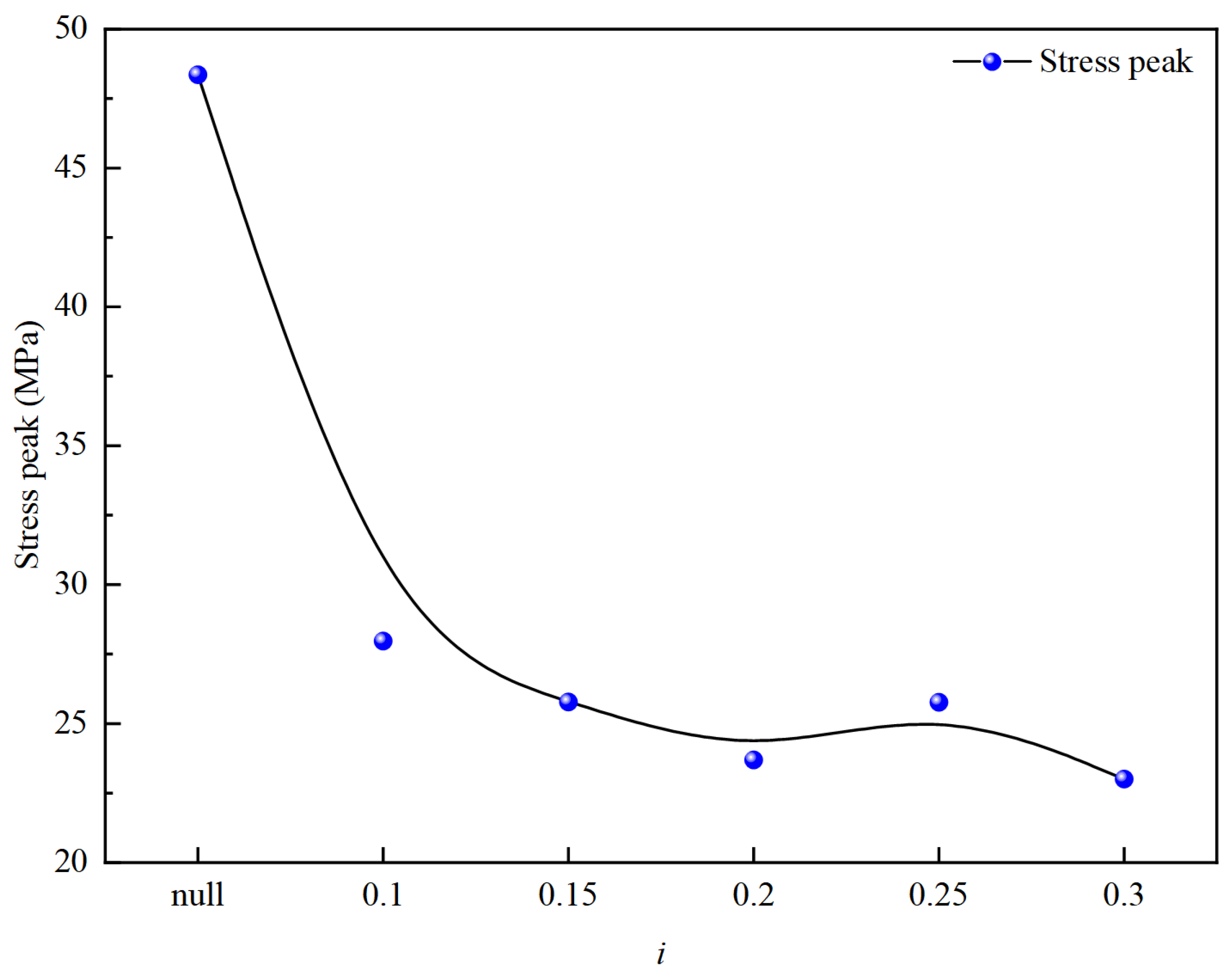
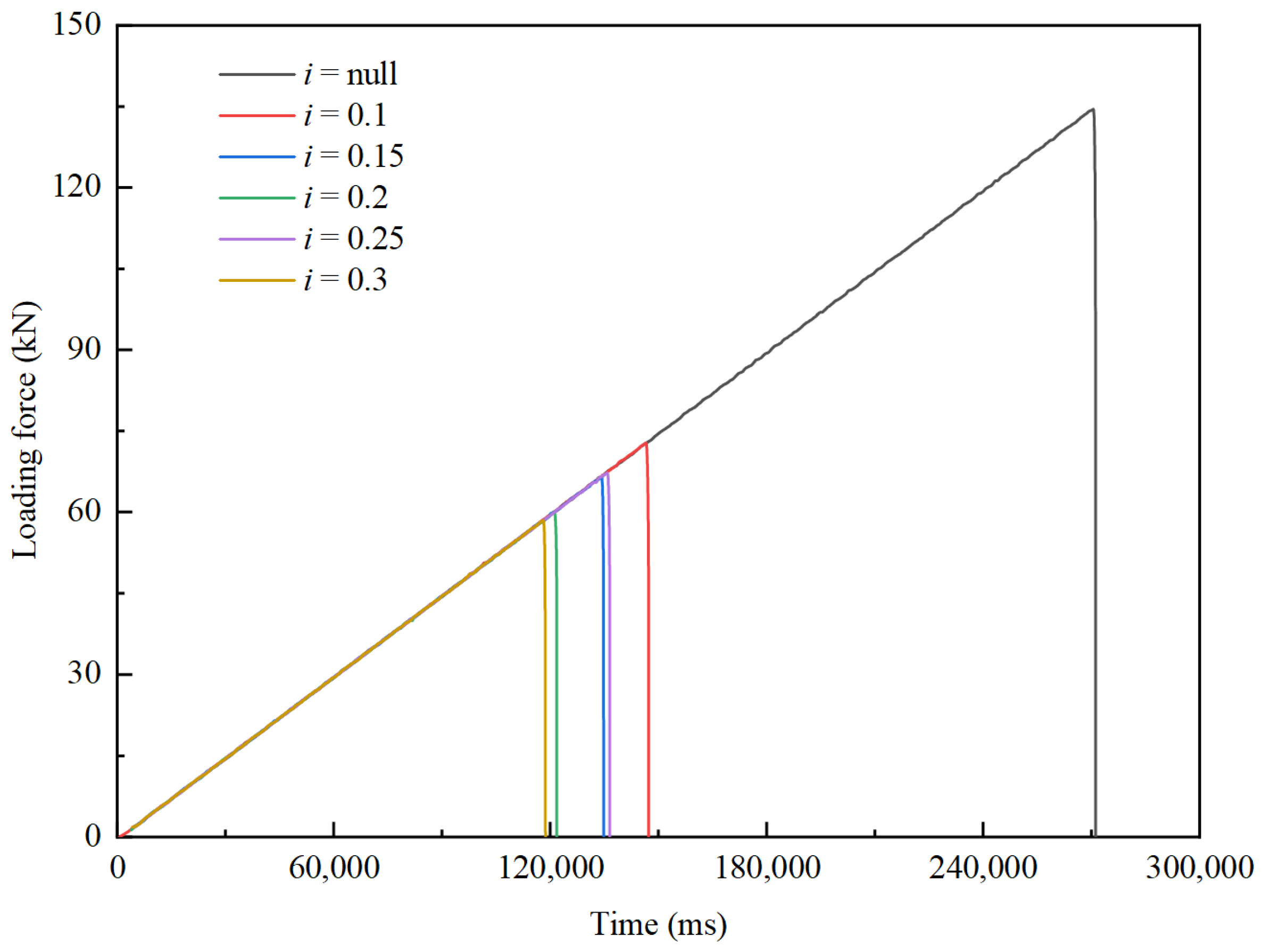

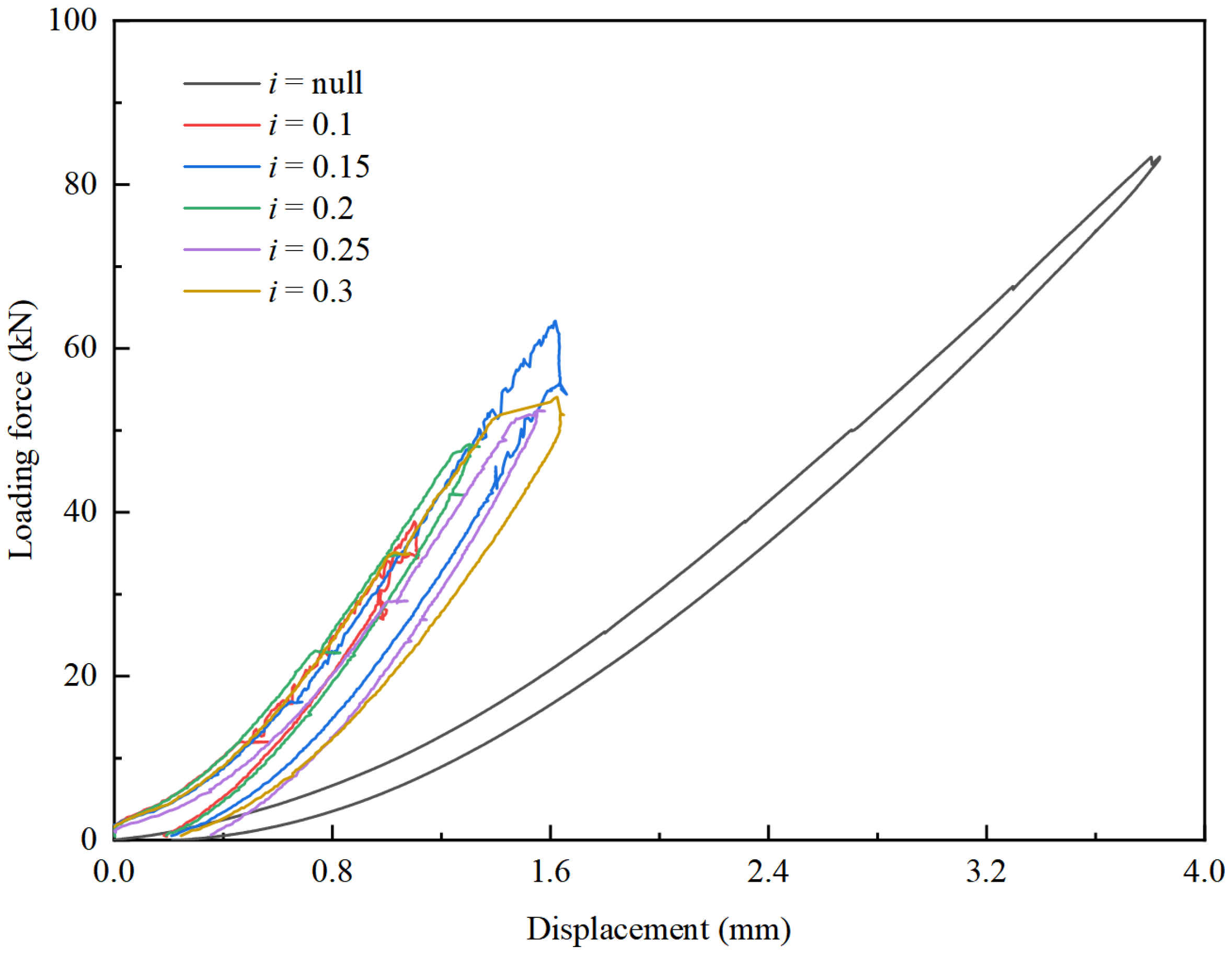
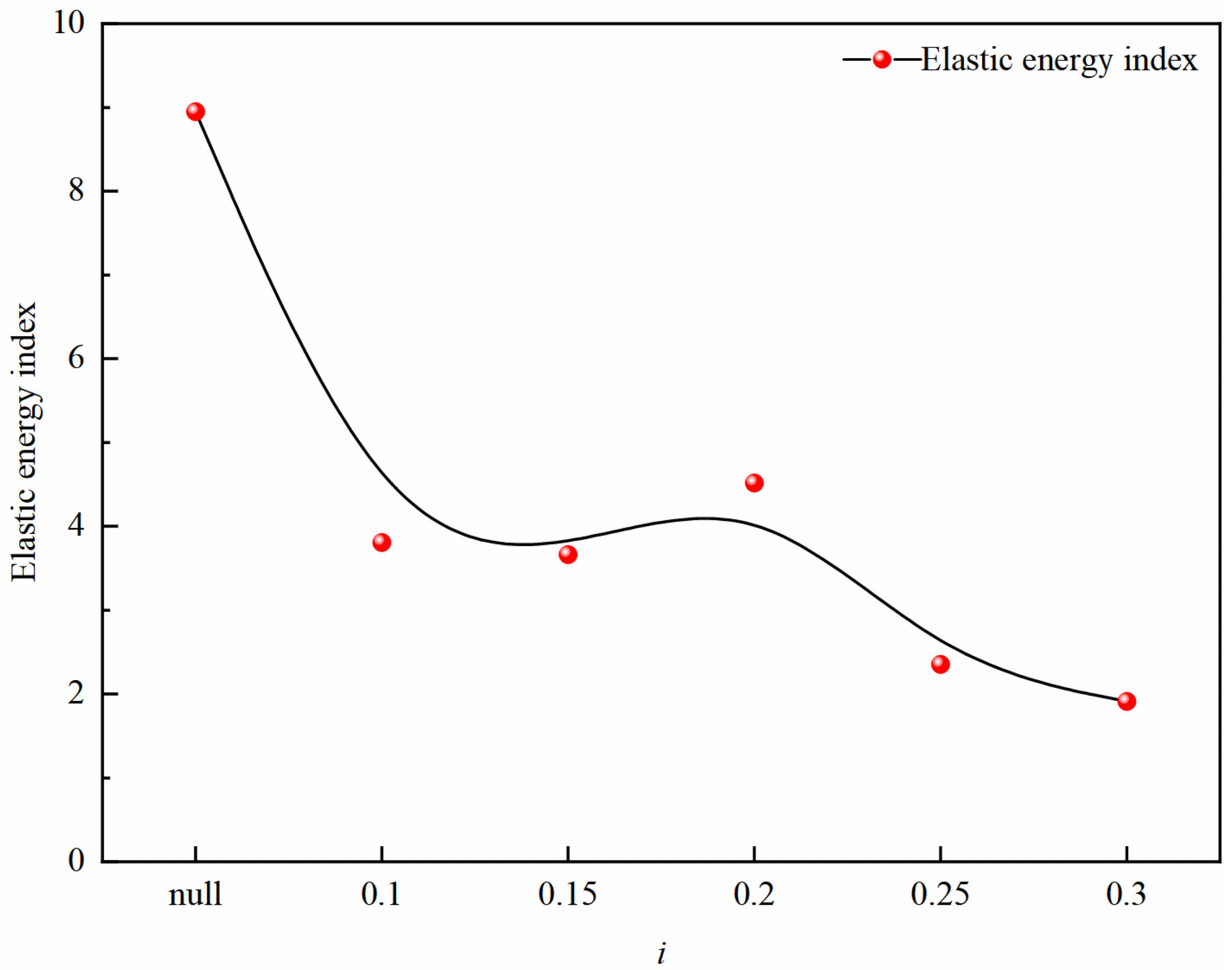
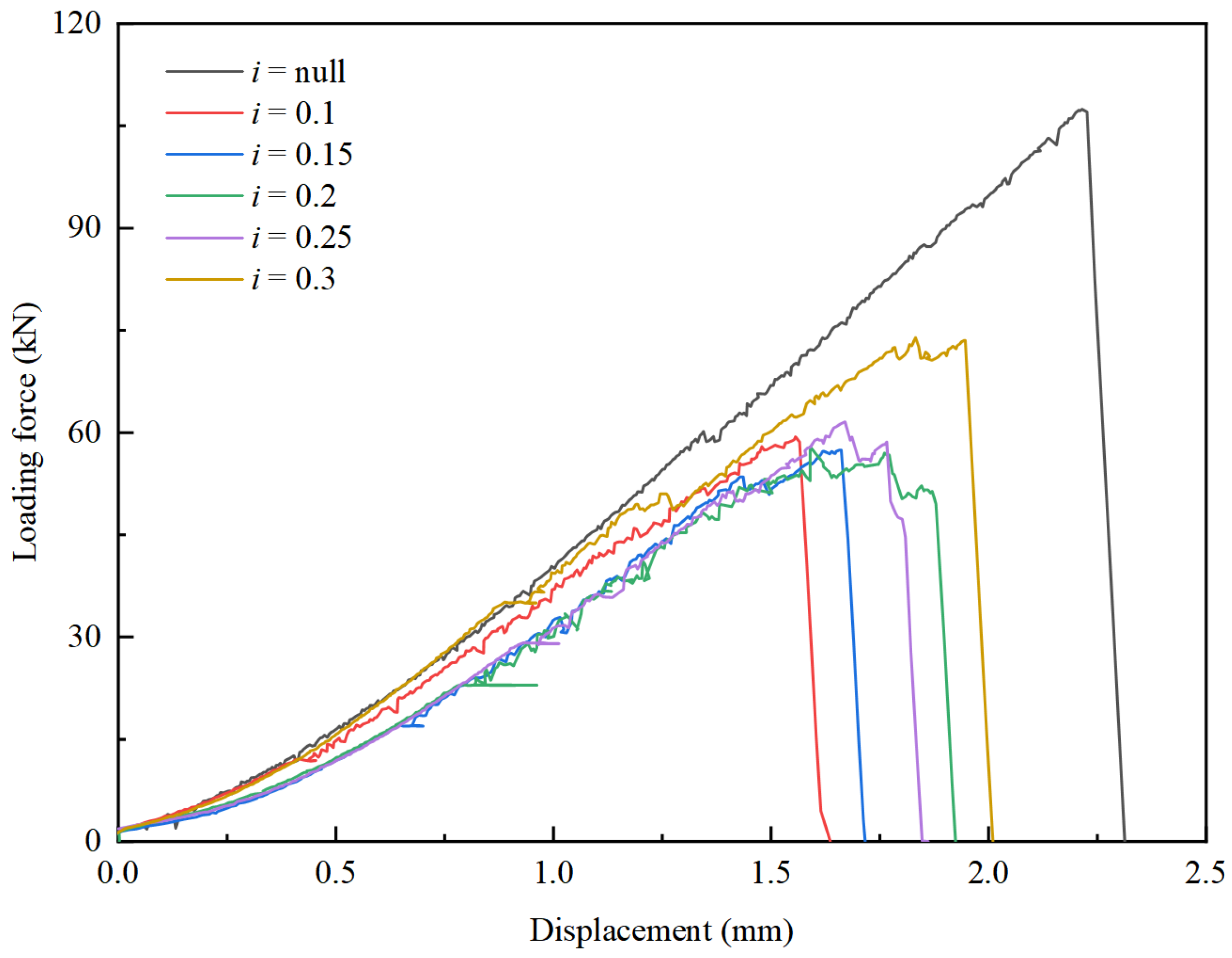
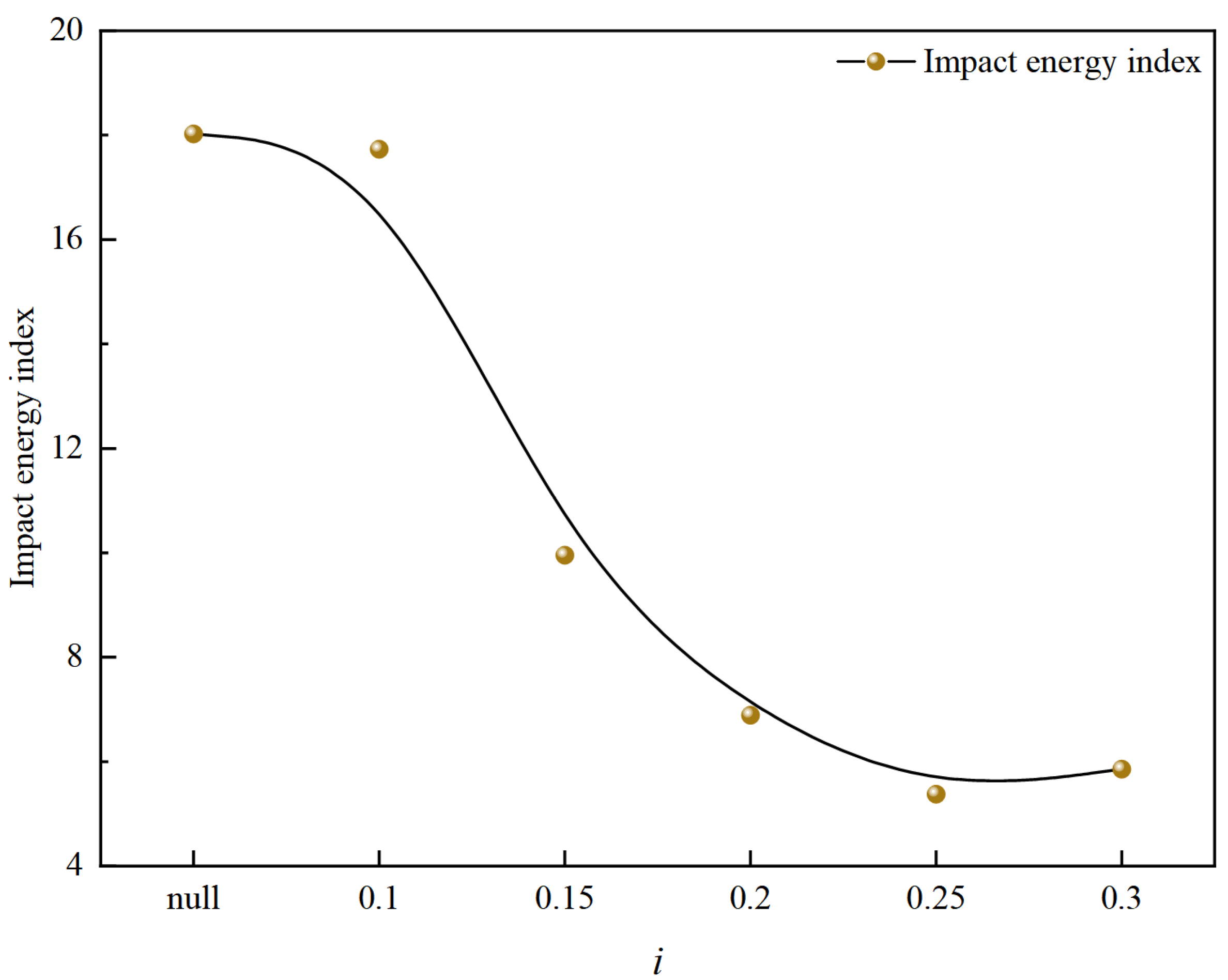
| Sample Number | Length (mm) | Width (mm) | Height (mm) |
|---|---|---|---|
| i = null–1 | 49.97 | 49.75 | 101.41 |
| i = null–2 | 50.81 | 50.38 | 100.12 |
| i = 0.1–1 | 51.99 | 51.30 | 100.76 |
| i = 0.1–2 | 51.12 | 50.28 | 100.19 |
| i = 0.15–1 | 51,35 | 50.82 | 99.75 |
| i = 0.15–2 | 51.51 | 49.06 | 99.75 |
| i = 0.2–1 | 50.82 | 50.80 | 99.07 |
| i = 0.2–2 | 50.08 | 51.37 | 100.21 |
| i = 0.25–1 | 50.96 | 49.81 | 99.51 |
| i = 0.25–2 | 51.59 | 49.86 | 100.36 |
| i = 0.3–1 | 51.21 | 51.11 | 99.89 |
| i = 0.3–2 | 50.94 | 49.28 | 100.24 |
| Index | Burst Tendency | Category | |||
|---|---|---|---|---|---|
| Dynamic Failure Time/ms | Elastic Energy Index | Impact Energy Index | Uniaxial Compressive Strength/MPa | ||
| DT > 500 | WET < 2 | KE < 1.5 | RC < 7 | No | I |
| 50 < DT ≤ 500 | 2 ≤ WET < 5 | 1.5 ≤ KE < 5 | 7 ≤ RC < 14 | Feebleness | II |
| DT ≤ 50 | WET ≥ 5 | KE ≥ 5 | RC ≥ 14 | Strong | III |
Disclaimer/Publisher’s Note: The statements, opinions and data contained in all publications are solely those of the individual author(s) and contributor(s) and not of MDPI and/or the editor(s). MDPI and/or the editor(s) disclaim responsibility for any injury to people or property resulting from any ideas, methods, instructions or products referred to in the content. |
© 2024 by the authors. Licensee MDPI, Basel, Switzerland. This article is an open access article distributed under the terms and conditions of the Creative Commons Attribution (CC BY) license (https://creativecommons.org/licenses/by/4.0/).
Share and Cite
Dai, L.; Du, F.; Zhang, X.; Zhao, X.; Yang, H.; Liu, Y.; Zhang, Y. Impact Tendency Characteristics of Borehole Coal Samples under Real-Time and Uniaxial Loading Conditions: Insights from Physical Experiments. Processes 2024, 12, 2189. https://doi.org/10.3390/pr12102189
Dai L, Du F, Zhang X, Zhao X, Yang H, Liu Y, Zhang Y. Impact Tendency Characteristics of Borehole Coal Samples under Real-Time and Uniaxial Loading Conditions: Insights from Physical Experiments. Processes. 2024; 12(10):2189. https://doi.org/10.3390/pr12102189
Chicago/Turabian StyleDai, Linchao, Feng Du, Xiang Zhang, Xusheng Zhao, Huiming Yang, Yanbao Liu, and Yi Zhang. 2024. "Impact Tendency Characteristics of Borehole Coal Samples under Real-Time and Uniaxial Loading Conditions: Insights from Physical Experiments" Processes 12, no. 10: 2189. https://doi.org/10.3390/pr12102189
APA StyleDai, L., Du, F., Zhang, X., Zhao, X., Yang, H., Liu, Y., & Zhang, Y. (2024). Impact Tendency Characteristics of Borehole Coal Samples under Real-Time and Uniaxial Loading Conditions: Insights from Physical Experiments. Processes, 12(10), 2189. https://doi.org/10.3390/pr12102189







